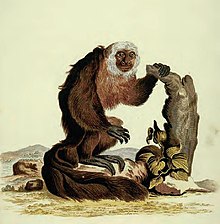
The Pitheciidae are one of the five families of New World monkeys now recognised. Formerly, they were included in the family Atelidae. The family includes the titis, saki monkeys and uakaris. Most species are native to the Amazon region of Brazil, with some being found from Colombia in the north to Bolivia in the south.

The bearded sakis, or cuxiús, are five or six species of New World monkeys, classified in the genus Chiropotes. They live in the eastern and central Amazon in South America, ranging through southern Venezuela, Guyana, Suriname, French Guiana and northern and central Brazil. The species are entirely allopatric, their distributions being separated by major rivers.
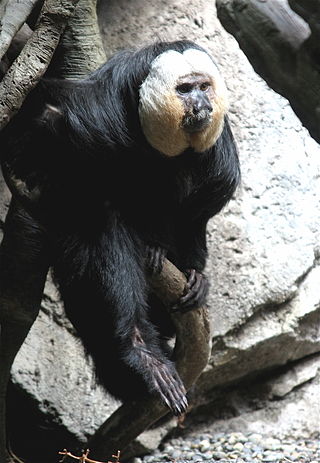
Sakis, or saki monkeys, are any of several New World monkeys of the genus Pithecia. They are closely related to the bearded sakis of genus Chiropotes.

Pitheciinae is a subfamily of the New World monkey family Pitheciidae. It contains three genera and 14 species. Pitheciines are forest dwellers from northern and central South America, east of the Andes.

The white-faced saki, called the Guianan saki and the golden-faced saki, is a species of the New World saki monkey. They can be found in Brazil, French Guiana, Guyana, Suriname and Venezuela. This species lives in the understory and lower canopy of the forest, feeding mostly on fruits, nuts, seeds, and insects. Although they are arboreal creatures and are specialists of swinging from tree to tree (brachiation), they are also terrestrial when foraging. White-faced sakis typically live around 14 years in their natural habitat and have been recorded to live up to 36 years in captivity. Sakis are active in the day and sleep highly elevated (15-20m) in trees with many leaves to shelter them from weather and flying predators.
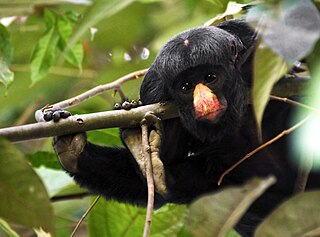
The white-nosed saki is a species of bearded saki, a type of New World monkey, endemic to the south-central Amazon rainforest in Brazil. Both its scientific and common name were caused by the authors working from dead specimens, where the skin on and around the nose fades to a whitish color. In living individuals, the nose is actually bright pink. Pelage on the body tends to be black in males and brown to brownish-grey in females. No other species of the genus Chiropotes have a brightly coloured nose.

The monk saki also known as Geoffroy's monk saki, is a species of saki monkey, a type of New World monkey, from South America. It is found in forested areas of northwestern Brazil and northeastern Peru.

The white-footed saki, buffy saki or white saki is a species of saki monkey, a type of New World monkey, endemic to western Brazil south of the Amazon.

The black bearded saki is a species of New World monkey, native to the Amazon rainforest of South America, specifically to an area of north-eastern Brazil. It is one of five species of bearded saki. Bearded sakis are medium-sized (50 cm), mostly frugivorous primates, specialised in seed predation. The genus name Chiropotes means "hand-drinker" as they have been observed using their hands as ladles for scooping water into their mouths. This behavior is thought to be a way of maintaining and protecting their characteristic beards. The black bearded saki's habitat has undergone heavy habitat fragmentation, making the future conservation status of the species uncertain.
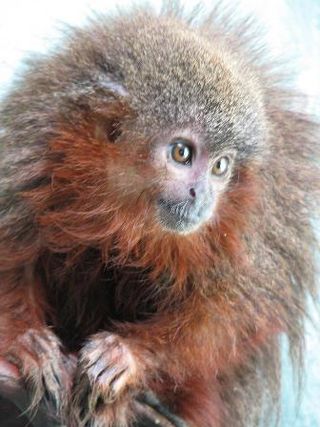
The Caquetá titi monkey, also known as the red-bearded titi or the bushy-bearded titi, is a species of titi monkey endemic to Colombia found in the Department of Caquetá region. Taxonomically, it is a member of the "Callicebus cupreus group", following Shunsuke Kobayashi's Callicebus grouping. It was first described by Thomas Defler, Marta Bueno and Javier Garcia in 2010. It is highly endangered due to habitat fragmentation and a small population.
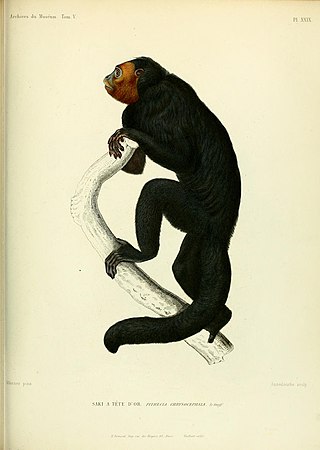
The golden-faced saki is a species of saki monkey, a type of New World monkey. It is found in Brazil north of the Amazon, on both sides of the Rio Negro. This species was formerly considered a subspecies of the white-faced saki, but was raised to full species status in 2014. The species is named for the coloration of the male, which has black body hair but orange or red-brown facial hair. The female has lighter body color and more bare skin on the face, with lines of orange hair extending down from below the eyes around the snout, as well as orange ventral fur. The golden-faced saki features a smaller, less prognathic, and less spherical cranial vault than the white-faced saki.

Miller's saki, also known as Miller's monk saki, is a species of saki monkey, a type of New World monkey. Its range includes parts of southwestern Colombia, northeastern Ecuador, and perhaps adjacent areas in Peru. This species was originally described as a species by J. A. Allen, demoted to a subspecies of the monk saki in 1987, and raised back to full species status in 2014. Confusion over the taxonomy of saki monkeys has arisen in part due to poorly labeled or mislabeled museum specimens. Males and females of this species, like those of other sakis, have differently colored pelage, with the females being more grayish in the face and overall, and the males a darker, grizzled black but with brown in the face and forearms.

The Napo saki, also known as the Napo monk saki, is a species of saki monkey, a type of New World monkey. Its range includes parts of eastern Ecuador and northern Peru. The name is derived from the Napo River in its locality. This species was originally described by Lönnberg as the subspecies Pithecia monachus napensis and has been treated as a synonym of P. monachus monachus. Hershkovitz retained it under P. monachus in 1987, but it was raised to full species status in 2014.

Vanzolini's bald-faced saki is a species of saki monkey, a type of New World monkey. Its range is in western Brazil. The monkey is named after Brazilian zoologist Paulo Vanzolini. This species was originally described by Hershkovitz as the subspecies Pithecia irrorata vanzolinii based on individuals collected in 1936 by Alfonso M. Olalla, but it was raised to full species status in 2014. For many years, there had been no record of the species in nature. Further specimens were collected in 1956 by Fernando Novaes and his assistant Miguel Moreira. The mammals in this expedition were collected alive and prepared as museum specimens, as described by Cory T. Carvalho, the mammalogist working at the Goeldi museum at the time.
Cazuza's saki is a species of saki monkey, a type of New World monkey. It is endemic to northwestern Brazil.

The burnished saki is a species of saki monkey, a type of New World monkey. It is found in central Peru and a small portion of adjacent Brazil.
Isabel's saki is a species of saki monkey, a type of New World monkey. It is endemic to a small portion of northern Peru.
Mittermeier's Tapajós saki is a disputed species of saki monkey, a type of New World monkey. It is endemic to west-central Brazil.
Pissinatti's saki or Pissinatti's bald-faced saki is a disputed species of saki monkey, a type of New World monkey. It is endemic to Brazil.
Rylands' bald-faced saki is a disputed species of saki monkey, a type of New World monkey. It is found in Bolivia, Peru, and Brazil.
